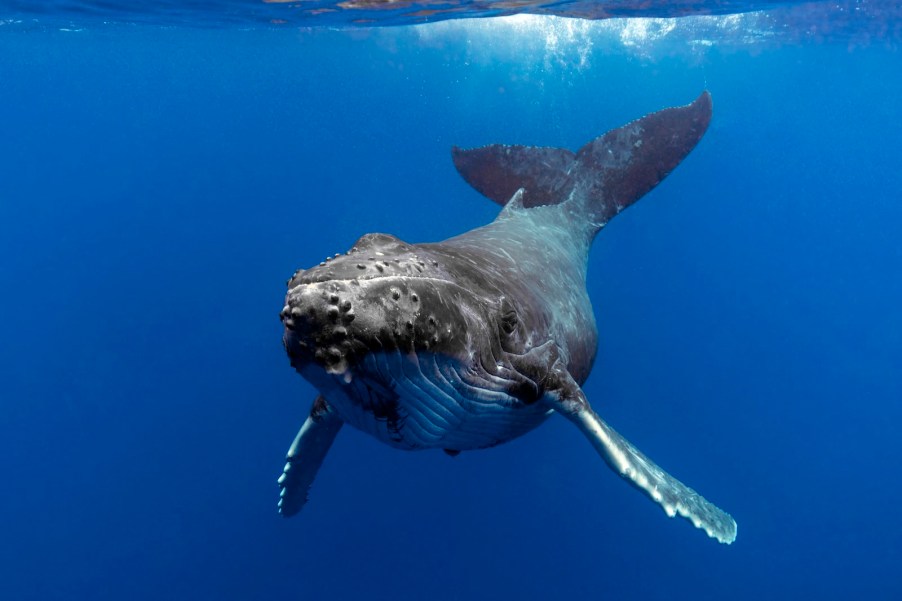
Boater swallowed by whale and spit back out, “Oh my God, I’m alive!”
Imagine you’re 35 feet underwater off the coast of Cape Cod, just doing your job. The water’s clear, visibility is 20 feet, and you’re having a pretty solid dive. Then suddenly—wham—total darkness. What’s your first thought? Shark attack? Maybe. But for Michael Packard, it was something way weirder. He wasn’t in a shark’s mouth. He was inside a whale. Yeah, you read that right. And no, this isn’t the next big Hollywood blockbuster—it’s just another day in the life of a Cape Cod lobsterman.
This June day, in 2021, started like any other. Packard and his crewmate set out in his lobster boat, Ja’n J, ready to pull in another day’s catch. Conditions were ideal off the coast of Provincetown—clear skies, calm seas, and great underwater visibility. After anchoring the boat, Packard donned his scuba gear, likely preparing to check some lobster traps or a mooring. Standard stuff for a guy who’s been diving for over 40 years.
But 35 feet down, things quickly took a turn for the strange. Out of nowhere, something hit him—hard. Packard found himself in total darkness. Instantly, his mind raced to the area’s infamous great white sharks. “I thought I got bit by a shark,” Packard told ABC. Panic set in as he felt around, expecting to brush up against rows of sharp teeth. “But there were no teeth,” he realized. And that’s when it hit him. “Oh my God, I’m in a whale’s mouth, and he’s trying to swallow me. This is it, I’m going to die.” (BBC)
For about 30 to 40 seconds, Packard was completely at the mercy of the leviathon. He could feel the whale’s muscles contracting around him as it moved through the water. At that point, he was basically hook, line, and sinker in a situation no diver prepares for.
“Then I saw light. White water everywhere. I was thrown from its mouth. It was shaking its head, trying to eject me.”
Up on the boat, his crewmate had been scanning the water anxiously for any sign of bubbles from Packard’s respirator. Instead, he got a sight he’d never forget. Joe Francis, a charter boat captain who witnessed the entire event said, “I wasn’t sure what it was. I saw the white flipper fin on the side. I said, ‘That’s a whale.’ I saw Mike feet first coming out of the water.”
Packard told ABC. After being spat out, he surfaced in shock, but grateful. “As soon as I landed in the water–and was floating there in excruciating pain—I was like, ‘oh my god, I’m alive.”
For those skeptical of Packard’s wild whale tale, rest assured this is no fish story. According to marine experts, humpback whales usually feed by opening their mouths wide to scoop up krill and small fish. They’re not known for swallowing humans, thanks to their highly developed echolocation. But in this case, it seems the whale might have mistaken the bubbles from Packard’s diving gear for a school of fish. Francis confirmed Packard’s account was no tall tale—it was a whale of a mistake.
While a close encounter like this is incredibly rare, it’s important to note that whales don’t see humans as prey. “What happened to Mr. Packard was in all likelihood purely accidental,” a marine expert told the BBC. Packard was simply in the wrong place at the wrong time—and even so, the whale made a mistake.
Despite his terrifying brush with the deep, Packard has no plans to hang up his diving gear. He’s determined to get back in the water as soon as his dislocated knee is healed. “I thought about my wife and two boys,” Packard told the BBC, recalling those heart-stopping moments when he believed his life was over. But after surviving this one-in-a-million encounter he wants to go back to work.
Whale, well, well, what’s the takeaway here? If you’re diving off the coast of Provincetown, keep blowing bubbles and trust that the whales are using their sonar.



